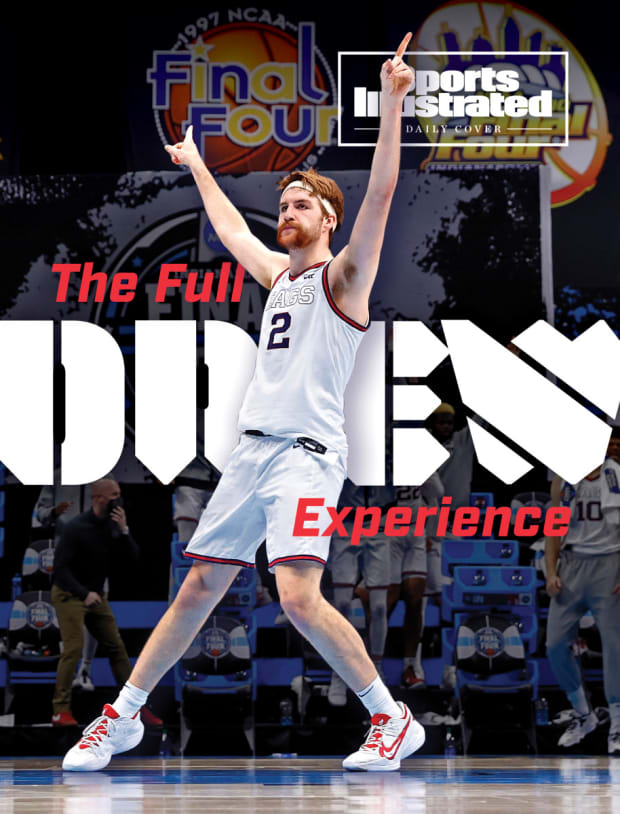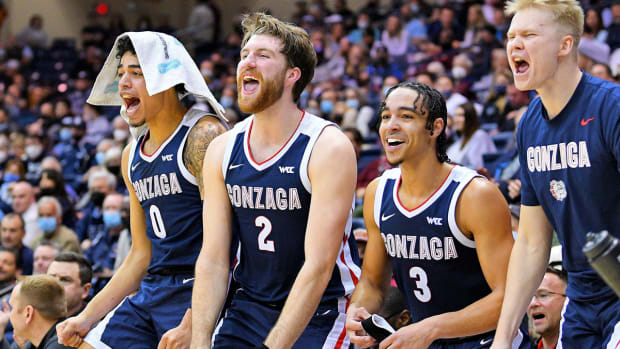Gonzaga’s big man returned for a fourth season to chase an elusive title—and spread more of his unique brand of joy.
Last spring, at a biology class on the Spokane River, Gonzaga basketballers Drew Timme and Anton Watson encountered a tall-person problem: They could not find lab-issued boots large enough for their gargantuan feet. Timme, because he is Timme, crammed his size-18 human snowshoes halfway into the biggest pair available, then skipped down to the banks, which were lined with trees and rock formations, dark-blue water sparkling in the sun.
The man and his majestic mustache then waded into the water to hunt for insects and frogs. Suddenly, Watson spied a crawfish, which he plucked and held high. Timme began cheering. Timme led a chant. Timme recoiled in mock horror as Watson placed the still-crawling crustacean onto his neck.

Jamie Squire/Getty Images
This is Timme, elite and authentic, hilarious and self-deprecating, normal and, well, not normal. Teammates describe similar daily interactions, always strange, as the Full Drew Experience (FDE), and they begin such descriptions with head shakes and giggles that make his mom, Megan, cringe. “I’m worried it could resonate like an episode of Jackass,” she says. “I mean, just totally ridiculous.”
The FDE starts with that ’stache, much to mom’s chagrin. It’s more than a ’stache; it’s a mission statement. The first time Timme told Watson he planned to trim his beard into a handlebar, Watson slapped palm to forehead. But the internet went bananas, forcing Drew to just go with it. Watson shrugs. “People like it,” he says. Another shrug. “I guess,” he spits out.
Because he is Timme, there’s an art to shaping the ’stache. It begins with a single simple rule: no soul patch. (He’s not a monster!) He’ll grow out a full beard, tire of it, then follow his instincts—but not before announcing to friends that “stache szn” has commenced. Some days, he feels like a copstache; others, a goatee; others, the famous Drew Manchu. “Always want to give it a little more pop,” Timme says.
Speaking of: The proclamations, methodology and designs that border on artwork are part of a loose plan that’s genius (and haphazard) (and charming). Timme is the rare college basketball star with modest NBA prospects, and he somehow managed to turn facial hair into a brand and an ethos. It explains him as well as anything explains anyone. “Just pure energy,” teammate Rasir Bolton says.
It has also made Timme—auburn-haired, strapping, dripping sweat—a meme and the subject of (mostly) light-hearted mockery. Comparisons abound. Relief pitcher near the end. Middle-aged plumber. Hockey goon. Mall cop. Jackie Moon, the singer/player/team owner played by Will Ferrell in Semi-Pro.
Timme is, as Dollar Shave Club declared in one endorsement, sports’ most celebrated “chin-fluencer.”
Because this is Timme, no one considers his perch at the rare intersection of ’stache and sports all that unusual. Not for a forward who spent this summer watching—sorry, Mom!—every Jackass movie, giggling at the nut shots and studying the acting. Not for a dude who creates personalized routines for his pregame introduction, an amalgam of fist bumps, headbutts, chest bumps, thumb wars and handshakes that can include everyone from a ball boy to Zags coach Mark Few.
The FDE is headbands. WWE-style celebrations after baskets. It’s fun. Self-aware. It’s an inquisitiveness that sees Timme sparking conversations with opposing coaches . . . during warmups. He loves Dos Equis—because, of course he does. He is the most interesting man in college basketball.
Why does any of this matter? Because Timme is also Gonzaga basketball, from where it started, to how it’s going, to the one thing he’s trying to shape above all else: the only thing the Zags have never won.

James Snook/USA TODAY Sports
As Drew Timme ambles toward an interview in early September, his presence is announced from 100 yards away. Timme laughs. Timme shouts. Timme cackles. Because he is Timme, an entrance must be made.
At his essence, this is Timme: pure, unadulterated, injectable joy bottled into a lumpy, towering body. The ’stache is his spigot, spreading unbridled enthusiasm throughout his world and far beyond. He describes the FDE like this: I love what I do. And the way I play, it’s an extension of me. It’s who I am.
This matters because he is Timme, a distinct headliner for college basketball’s most unlikely power. Gonzaga is a small school in a remote location. But that hasn’t stopped expectations from ballooning beyond what’s reasonable. Winning is both demanded and taken for granted in Spokane. It has looked so easy, especially in Timme’s first three seasons, when the Zags went 90–7. Or in 2020–21, when they nearly completed an undefeated year, their lone defeat coming to Baylor in the national title game. Timme is a two-time All-American, the reigning West Coast Conference Player of the Year and one of the country’s most productive big men. But what might seem easy most definitely is not. “People don’t realize how hard it really is,” he says.
Inside the crucible of demand and intensity that is Gonzaga basketball, even small booster shots of Timme-brand joy stretch far beyond his wingspan. They strengthen team dynamics, ward off negativity and make an enterprise that’s basically big business feel less heavy.
Even then, the FDE wasn’t always this way. Growing up in the Dallas suburb of Richardson, a 6' 10" high schooler who couldn’t yet grow a mustache. He cared too much and tried too hard. “Serious and scared,” Timme says of his younger self. When told he wasn’t good enough or tough enough by a youth coach, Timme responded by maximizing his gifts. The connection he made—that sports should, ultimately, be fun—only made him a better player. He vowed to never lose that vibe again.
Matt and Megan Timme raised three children—each tall, each an athlete, each so competitive they still vociferously claim the coveted title of Timme tic-tac-toe champion. In this forest of a family, Matt played hoops at SMU, where he studied psychology, and later competed in Europe. Megan, a college tennis player at Stephen F. Austin, became an educator in Richardson, where she’s now on the school district’s board of trustees. Son Walker, the middle child, is a freshman forward at McNeese State. Daughter Kendall, the youngest, is a high school volleyball prospect.
They all know Drew as the world came to understand him: “Just so goofy and dumb,” Megan says, as a compliment. But they also knew the Drew that actively made the FDE possible. That Drew showed up at practices for Drive Nation—the AAU program started by former NBA All-Star Jermaine O’Neal—in Uggs and cut-off T-shirts before turning laughter into awe. Timme sought extra time with O’Neal, peppering him with questions about footwork and positioning.
Eventually, Gonzaga assistant Brian Michaelson called to invite Timme for an official visit. And, Timme being Timme, he fell in love, though
not for the obvious reason. It wasn’t just that he was enamored with basketball, all the banners hanging in the practice facility Few built. Hoops mattered, of course—but not as much as how normal everything felt on campus. “I want that,” he told his parents, meaning: rubbery cafeteria spaghetti, cramped dorm rooms and no sports silos. Not to mention Few, the coach who never left and never planned to, the teacher with more seasons coaching at Gonzaga (23) than candles on Timme’s last birthday cake (22).
“He always finds his value, his niche,” Megan says. “That’s what we always taught him. This is your job: being a good human being.”
Her son—a human being currently in good standing everywhere except on campus at rival BYU—didn’t lack for scholarship offers. Michigan State. Texas. Arizona. Texas A&M. Drew made a pivotal choice in 2019. He picked Gonzaga, the perfect incubator for a brand he didn’t know existed yet. He chose joy, because he is Timme.

Timme got his slice of normal. Gonzaga, in return, got normal’s antithesis. It didn’t take long for Few to bestow his Jackass-loving forward with a new moniker, as Timme became Gonzaga’s “union rep.” This owed to Timme’s myriad (but friendly) complaints to management. Like whenever practice ran a little long. Or when Mount Few threatened to erupt.
Timme’s parents had worried his personality might be naturally dulled in college. They were wrong. “Drew’s gonna be Drew, right?” Matt says. And that, in fact, was exactly what Gonzaga wanted. Not subdued Drew. Not clean-shaven Drew. Only the FDE would do, which spoke to the culture that Few had nurtured for more than two decades.
Most programs deploy culture as a buzzword—like junk food, it’s empty calories. Not the Zags. Few certainly didn’t design the spirit of Gonzaga basketball with Timme in mind. But he did fashion a hoops laboratory that celebrated individuality, welcoming all types, from all over the world. If that meant the 59-year-old coach chest-bumping the mustachioed baller during intros, so be it. “He’s got a low center of gravity,” Timme explains with a smirk.
His evolution started immediately.
Year 1: Surprisingly productive freshman season. Spent backing up the conference player of the year, Filip Petrusev, along with spot starts whenever Killian Tillie missed time. Too much fun off the court. Not enough fun on it, as the postseason was canceled with the No. 2 Zags sitting at 31–2. Blame COVID-19.
Year 2: Unexpected star turn. Petrusev, a native of Serbia, decided to stay and play in his homeland. Forward Corey Kispert and shooting guard Joel Ayayi returned, while future NBA lottery pick Jalen Suggs arrived. Timme grabbed onto a larger role. He set screens. He slid into space. He galloped—as much as someone who’s built like him can gallop—down the floor in transition. After averaging 19.0 points and 7.0 rebounds per game, Timme did not jump to the NBA, a decision he explains in five words. “I just like kicking ass.”
Year 3: The takeover. Suggs left. But in came Chet Holmgren, a 7' 1" center known as The Unicorn. Consider Holmgren—a serious player ticketed for stardom from an early age—and Timme the world’s tallest yin and yang. Gonzaga became less perimeter-oriented, while Timme waded deeper into the post.
Travis Knight, the school’s strength and conditioning coach, came to believe everyone could follow Timme toward the rarest of places: happiness. The kindergarten mentality his coaches described wasn’t an insult. Yes, dealing with children that young is frustrating. But strip away busy schedules and endless workweeks and so much self-induced stress: Most adults would love nothing more than to return to that state. Because he is Timme, he lives there, population 1 ½. Just a man and his mustache, shaping and smiling through another season.
Which leads to the intersection of his joy and competitive nature: moves shaped by sweat equity, deployed with an enthusiasm normally reserved for train sets and Santa Claus. Those moves . . . they have moves. Jab steps and long strides; spins and pivots and pump-fakes and flying elbows; baby hooks and skyhooks and jump hooks; up-and-unders and crossovers and fadeaways.
Proof came in last year’s NCAA tournament, in a second-round clash with ninth-seeded Memphis. After the Tigers shot to a 10-point lead at halftime, Few calmly addressed his team, insisting they would come back. He then ceded the floor to the FDE—and Timme’s words were neither calm nor G-rated. As he dropped f-bombs, telling teammates they “weren’t going out like this,” the mood changed. And, when the game resumed, Timme unveiled his full arsenal, prompting Watson to say he witnessed “the most unstoppable force I’ve ever seen.”
In only four minutes, Timme scored 11 straight points. As Adam Morrison—Zags legend, color analyst and precursor for mustache-tinged stardom—watched, he became mesmerized. “Some of those moves I hadn’t even seen,” he says.
Gonzaga won, advancing to the Sweet 16. Timme retreated to his hotel room to play Super Smash Bros. But the Bulldogs lost to Arkansas five days later and, once again, the program’s swollen expectations made a wildly successful season seem like something less. So 28–4 was a failure? Really?
Timme did not play video games that night. Nor did he consider whether he might leave school. Instead, he went out with his family, enjoying rum-and-Cokes before turning to his favorite beer. He let the central question linger. Would he take not just his talents but his distinct joy to the NBA?

Brian Rothmuller/Icon Sportswire/Getty Images
Six months later, there’s Timme, on the Zags’ practice court, spinning and twisting and scoring like he never wanted to leave. Twenty-six banners of NBA players from Gonzaga hang from a wall nearby, soon to be joined by two more: Holmgren, the top pick of the Thunder, and point guard Andrew Nembhard, who was selected by the Pacers. Timme’s beard is fully grown, just itching for its first shaping of another season. “Gonzaga makes me happy,” he says.
He did take a long, atypically serious look at professional basketball. But in the way only he could, because he is Timme. He started with an easy baseline, deciding to participate in the combine and team workouts. He wanted to gauge the possibilities, and he couldn’t do that if he didn’t play. But he promised himself he wouldn’t lose the joy that now defined him.
He also left Bolton, a combo guard, and wing Julian Strawther—both NBA-caliber players—to make their own decisions on returning. He didn’t want to be the kind of influence he himself was avoiding. Perhaps the most nervous person in greater Spokane was his buddy Watson, who knew, like everyone, that Holmgren and Nembhard would jump—and who wondered, like everyone, whether the other three would, too.
Timme made a loose list of pros and cons. Timme played. Timme weighed. Timme vacillated. A solid combine appearance pushed him toward declaring, though most mock drafts had him as a second-rounder. Everything else—normalcy, Few, Watson, biology, the chance to win an elusive title—made him reconsider.
On the morning of the deadline, Timme still wasn’t sure. He had just returned from a workout with the Warriors, which he had prepared for by watching WWE highlights. Because he is Timme and he finds professional wrestling relaxing, it had gone well.
He settled in front of his Xbox at the family’s home in Texas and
cued up FIFA 22, pushing buttons and continuing to assess. The NBA meant immediate salary and a quicker path to the pros, the start of his next life. Gonzaga meant completing his degree in sports management and remaining part of the family, plus another run that would only (in theory) make him a better prospect. But he would need to prove that, too, by improving in the ways professional teams desired: switching off ball screens, draining threes, stretching the floor. His NBA teammates wouldn’t experience the full FDE, because after practices most would return home to their families.
Leaving, he decided, constituted a bigger gamble—and that stemmed, in large part, from how the college basketball landscape had changed around him. His classmates at Gonzaga aren’t starstruck. But because of new NIL rules, he also was no longer like them. He could endorse products, bank millions and still laugh his way through marketing classes.
O’Neal, a member of the prep-to-pros generation, was 17 when Portland drafted him 17th in 1996, and 18 when he played his first pro game. He knew, better than Timme ever would, how joyless professional basketball could be at times. He started only 18 times in his first four seasons, and, while he survived that period and thrived afterward, he wasn’t sure that Timme needed to endure the same. Not if he no longer had to.
“I definitely would have gone [if not for rule changes],” Timme says. “Honestly, it’s great for college basketball.” He cites a Nov. 20 clash scheduled with Kentucky at nearby Spokane Arena, against fellow All-American big Oscar Tshiebwe. Two stars. Two pitchmen. Two powers. All without leaving college!
Morrison, asked how much money he might have made off his mustache in his era, if it had been allowed, just laughs. “Too wispy,” he says before pivoting back to Timme. “But it’s part of his brand, part of what makes him just a happy kid.”
Speaking of: Timme the brand had already partnered with a local casino, Northern Quest Resort; Boost Mobile; and, naturally, Dollar Shave Club. As decision day reached its final hour, Timme hung out with his parents. Really, he already knew. “Oh, my God,” Megan says. “So annoying. I’m a bundle of nerves, and he’s in there playing video games.”
Because he is Timme, he announced his choice with a two-word tweet, sent with 46 minutes to spare. “I’m back.” Bolton was so excited, he called his mom. He would return, too, along with Strawther, while Gonzaga added high-profile transfers in Malachi Smith (from Chattanooga) and Efton Reid (LSU), reconfiguring and repositioning for another run.
As he went back to his Xbox, Timme knew one thing with absolute certainty. It was time, once more, for ’stache szn.
In July, Pistons center Kelly Olynyk arrives late for his favorite annual tradition. It’s perfect and perfectly Gonzaga. In every non-pandemic year since 2015, during the NBA’s summer league, the Zags-to-pros generation has gathered with university support staff at places like Bavette’s to eat steak, drink wine and do impressions of Mount Few. At first, they needed only a single table. But now, having outgrown the dining room, they settle into a private space in back.
Five weeks after “I’m back,” Timme is notable for his absence, which is welcomed by those in attendance, because of what it means. Olynyk and Holmgren, who will soon see his rookie year postponed by a foot injury, share stories. Wizards forward Rui Hachimura passes around bottles of his new wine, Black Samurai.
Next year will be an even larger event. “I’m already making plans for a bigger room,” senior associate AD Jared Hertz says. One that can accommodate a personality the size of the FDE.
Timme is part of this tradition, this progression, that makes Gonzaga unlike any other power in college hoops. Holmgren suggests that Netflix give Timme his own show. “Timme Time?” Drew ponders. But while different—in vibe, headband and facial hair—from the Zags stars who came before, he’s also just like them. He calls Robert Sacre, the jovial former Lakers 7-footer, “my spirit animal.”
To consider Timme one of the Zags’ biggest personalities, rather than one of the program’s best-ever players, is to miss the ’stache shape for the individual hairs. While Olynyk doesn’t disagree with evaluators’ assessments of where Timme needs to improve, he also describes him as “an unbelievable basketball player” and “one of the most skilled I’ve ever seen.”
“I always worry,” Megan Timme says. “But I will say this: He [has] always found his way. It may not have been the way I wanted him to get through it. Or the way I thought he’d get there. And yet, he figures it out. He always finds his joy.”
For now, that’s in Spokane, where Drew Timme refuses to define success by national titles, endorsement income or mustache-awareness raised. It’s all part of the same experience, which, for his mother, is counterintuitive, but in the best possible way. Her son loves college basketball as much as anyone loves anything. Had the sport not changed its rules, however, to reflect what it really is—a billion-dollar business—he would have left.
Timme long ago cemented his place in Gonzaga basketball lore. He wasn’t what anyone expected. He was better. He was more. He was extra—all flash and ’stache and Riverdance-intro routines.
Forget all that for a moment, though. Lobbed impossible-but-related questions—How many players should be on Gonzaga’s Mt. Rushmore? Where would Timme fit?—Michaelson, the Zags’ assistant, waffles briefly, considering the options. Then he begins to think out loud. Timme has to be in the discussion. . . . He has been unbelievably consistent. . . . NCAA tournament wins. . . . Points amassed. . . . He’s gonna be a three-time All-American. . . . You start to add up what he’s done, and you’re talking about a very select group of guys. . . . Not even just at Gonzaga. . . . A very small group of guys in college basketball.
Top 15? Top 10? Top five? “I don’t care what criteria you use,” Michaelson says. “Drew goes on the smallest of small lists.”
Drew Timme, because he is Timme, can see it: The 2022–23 season unfolds. The Zags don’t lose. They win the title that no one can stop asking them about. “Then we throw a rager at McCarthy,” Timme says, referencing the arena he calls home, for now. His eyes twinkle at the thought of so many Dos Equis kegs, along with the ’stache he would shape for the celebration.
Watch Gonzaga games live with fuboTV: Start a free trial today!
More Daily Covers:
• The Astros Are World Champs—No Asterisk Needed
• The Unthinkable Kept Her From the 1993 New York Marathon. Now She’s Back
• Phony Environmentalism Comes to Sports